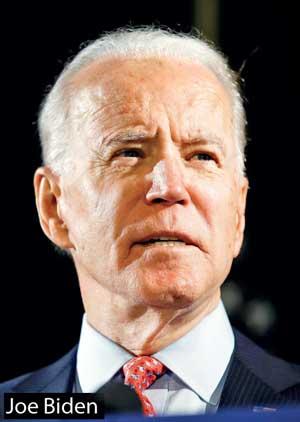Reply To:
Name - Reply Comment
 Joe Biden will assume office as the 46th President of USA on January 20, 2021. He defeated the incumbent Donald Trump in a bitterly fought contest. Biden polled 75.2m (50.7%) votes and has secured 290 of the 538 electoral college votes that are allocated among the states roughly in proportion to the size of the population in each state.
Joe Biden will assume office as the 46th President of USA on January 20, 2021. He defeated the incumbent Donald Trump in a bitterly fought contest. Biden polled 75.2m (50.7%) votes and has secured 290 of the 538 electoral college votes that are allocated among the states roughly in proportion to the size of the population in each state.
Trump polled 70.8m (47.7%) and has 214 Electoral College votes. The final vote tallies will be a little higher because some votes are yet to be counted. But those votes will not affect the result because Biden already has 290, that is above the minimum 270 needed to win.
 Usually, US Presidential Election winners are called within a few hours after the polls close. This time it dragged on for four days from November 3 to November 7.
Usually, US Presidential Election winners are called within a few hours after the polls close. This time it dragged on for four days from November 3 to November 7.
The main reason was the massive increase in mail-in voting that totalled about 65m and in-person early voting before November 3 that totalled 36m.
In some states, these were counted before November 3, but in some others only after the polls closed on November 3. The latter was mainly responsible for the delay in announcing the results.
Trump has refused to concede the race and has vowed to fight the results in courts of law on the grounds that there has been widespread fraud and corruption in voting and the count. The few cases that were filed after the polls closed have not been accepted by courts owing to lack of credible evidence. Trump may listen to his closest advisers many of whom realise that he has no path to victory and concede defeat.
The Old and the New
This election is an unusual combination of the old and the new. Joe Biden (Aged 77) is a political veteran with 48 years of political experience first as US Senator for Delaware (1973-2008) and as Vice President (VP) under Obama (2009-2015).
His VP-elect Kamala Harris (56) is relatively a newcomer to national politics. She was the Attorney General for the State of California before being elected to the US Senate in 2017. More importantly, she will become the first-ever woman VP as well as the first-ever VP of colour. Biden put together a fresh coalition of voters and made inroads into traditionally Republican states in the South such as Arizona and Georgia that may redraw the electoral map of USA.
He has to find a solution to the Covid-19 pandemic that took the entire world by surprise earlier this year. He also has to deal with old and embedded problems such as institutionalized racism in the country.
Politically, China has been quite comfortable with Trump who is a populist with authoritarian tendencies. A Biden administration almost certainly will be harder on human rights issues such as China’s suppression of democracy advocates in Hong Kong and the rights of the Uyghurs minority in Xinjiang in Northwest China
Mismanaging Covid-19
Biden made the election a referendum on Trump who was facing the electorate after an impeachment that the House of Representatives passed but the Senate rejected. Biden’s main critique of Trump was over the latter’s failure to handle the Covid-19 pandemic. By the second week of November US has reported over 10.0m cases and about 244,000 Covid-19 related deaths. The country is now on its second Covid-19 cycle with daily cases topping 100,000.
Economic Crisis
US voters usually give Presidents a second term when the economy is good and vote them out when it is bad. In 1992 Bill Clinton beat President George H. W. Bush because the economy turned sour with unemployment at 7.9% on the eve of the election in November. Under Obama, the unemployment rate dropped from 10.0% in 2008 to 7.9% in 2012 and he won a second term.
In January 2020 the US unemployment rate had reached a record low of 3.6% and middle-class incomes had risen under Trump. He was well placed for re-election. But the new coronavirus increased the unemployment rate to 14.7% in April. In September it was still a relatively high 7.9%.
About 100,000 small businesses have closed permanently attributable to the Covid-19 pandemic.
Trump narrowly lost the election last week notwithstanding his failure to control the Covid-19 pandemic and the bad economy. Had Trump controlled the pandemic more effectively the election result is likely to have been
very different.
Biden Coalition
Biden assembled a coalition of voters to achieve his victory. First, he managed to unite the Left-wing of the Democratic Party with its moderate wing to which he belongs. Second, he secured the support of about 87% to 90% of the African American voters who account for 13.4% of the population. Third, about 62% of Hispanics (16.7% of the population) also voted for him. Fourth, he did better with white voters than Mrs Hilary Clinton in 2016. As in 2016, this time also a majority of whites voted for Trump. But there were notable differences within the white voting block that helped Biden. Trump was the clear favourite of rural white voters and non-college-educated blue-collar white workers, especially males. But a majority of white college-educated voters in the cities and suburbs voted for Biden and in that group, women broke heavily in favour of Biden. It is a fact that older people are more vulnerable to the new coronavirus. Trump’s failure to fight the spread of the disease appears to have persuaded some white retirees to change sides and vote for Biden. Compared to 2016, more of the voters who have registered as “Independents” also supported Biden for various reasons including Trump’s style of governance that they found unacceptable.
Democratic administration will not be pleased with Hindu nationalist extremism associated with Prime Minister Narendra Modi’s BJP and the violence against Muslims that it causes. A Biden White House is likely to pay more attention to Sri Lanka’s democratic governance issues
Biden’s Plans
President-elect Biden, in his address to the nation on Saturday evening, promised to get to work immediately to address some of the most urgent issues facing the country. He will immediately appoint a presidential task force to fight the Covid-19 pandemic. USA will return to the WHO and re-join the Paris Climate Agreement. He will also reverse Trump’s executive order that stopped immigration to the USA from Muslim-majority countries. For the long term, his main message is that he would “heal” the country, promote unity, get rid of institutionalised racism, and be the president of all Americans, whether one supported him or not in the recent election.
Foreign Relations
Western capitals are certain to welcome the change after having had to cope with Trump’s foreign policy that was largely transactional and devoid of any substantive higher purpose such as preserving and promoting democratic values. Trump and Russia’s President Vladimir Putin have had a good relationship. Moscow would not be happy to see Trump leave.
China’s position is ambiguous. Some in the Chinese foreign policy establishment who focus on trade and other economic issues will welcome an opportunity that Biden may create to stop the trade war that Trump started and have a mutually beneficial trade agreement between the two countries. Biden is likely to continue Trump’s policy of protecting high-end US technology from reaching China through unauthorised channels.
Politically, China has been quite comfortable with Trump who is a populist with authoritarian tendencies. A Biden administration almost certainly will be harder on human rights issues such as China’s suppression democracy advocates in Hong Kong and the rights of the Uyghurs minority in Xinjiang in Northwest China.
The growing co-operation between India and USA on military matters is likely to continue. However, a Democratic administration will not be pleased with Hindu nationalist extremism associated with Prime Minister Narendra Modi’s BJP and the violence against Muslims that it causes.
A Biden White House is likely to pay more attention to Sri Lanka’s democratic governance issues.
Conclusions
In conclusion, we want to highlight three important long-term implications of this presidential election cycle. First, Biden’s win is a return to some kind of normalcy in US politics after a tumultuous four years of Trump. He came to Washington with a promise to drain the “swamp” – a reference to corrupt politics – but ended up creating his swamp. Appointment of family members and some individuals who funded his election campaign to senior positions in the administration for which they had little or no qualification is one example. The violation of some of the basic norms of US democracy, most notably ignoring, where possible, the separation powers between the legislature, executive and the judiciary is another.
Second, Trump’s poll of 71m against Biden’s 75m shows a sharply divided society. Trump voters who are predominantly white, more rural and blue-collar and Biden voters who are mostly urban minorities and whites with a college education living in the suburbs occupy one country. But the two groups inhabit almost two different worlds. The physical and economic separation is aggravated by social media that has further separated the two groups with each group creating its own social and cultural reality. There are deep socio-cultural, racial and structural reasons for the division observed. President-elect Biden calls for national unity. But it will not be easy to eliminate the divide.